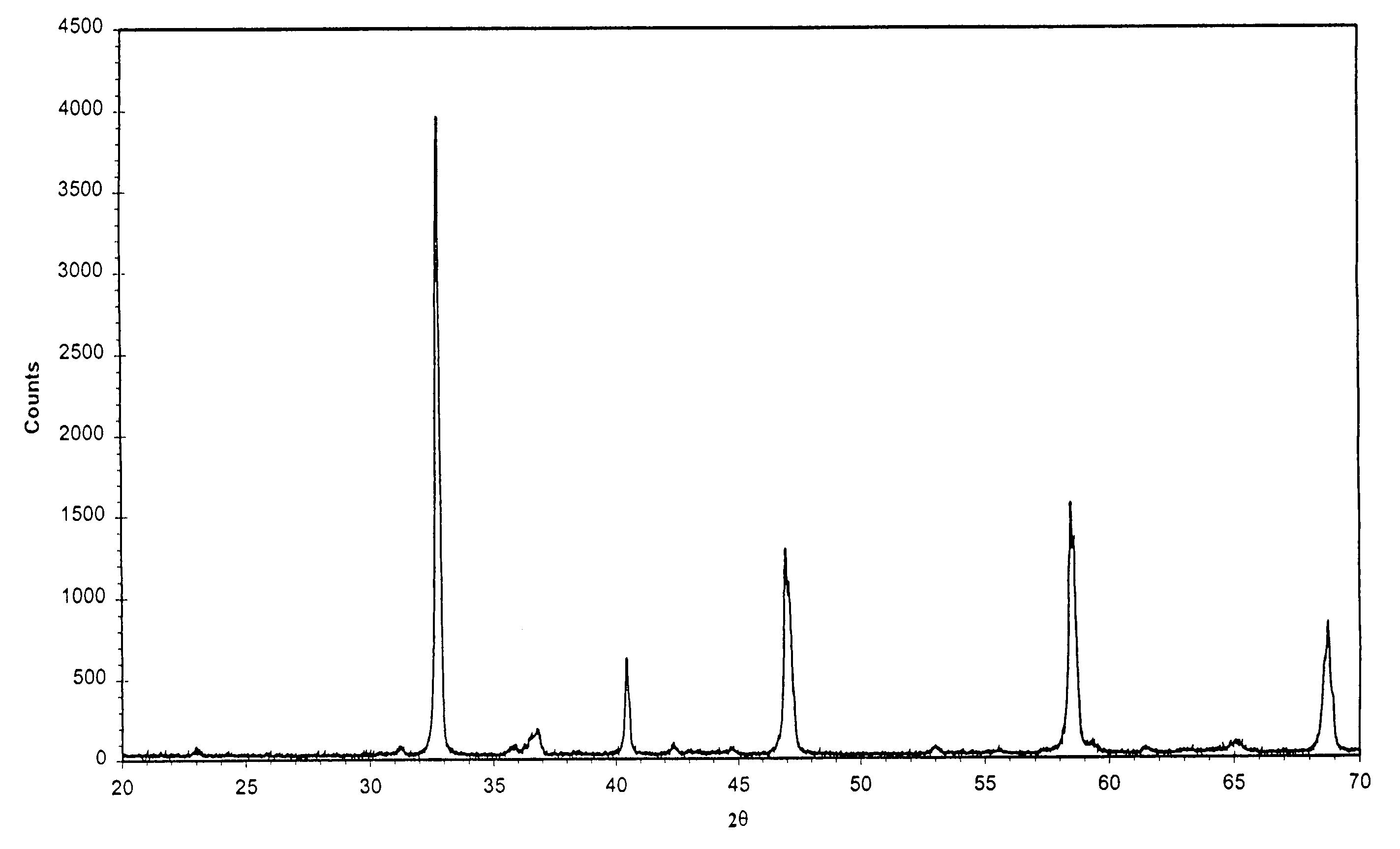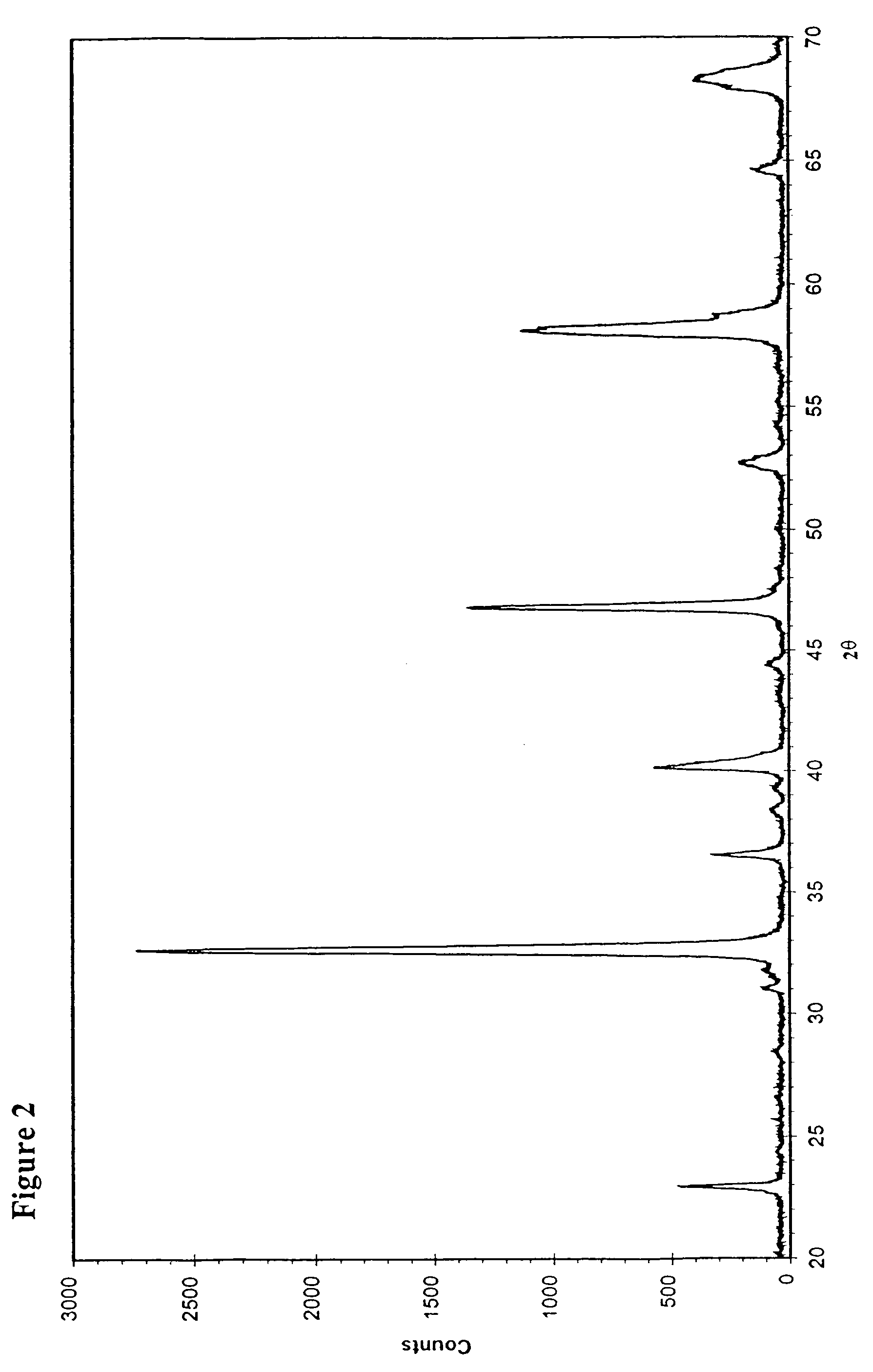Supported perovskite-type oxides and methods for preparation thereof
a technology of perovskite-type oxides and oxides, which is applied in the direction of metal/metal-oxide/metal-hydroxide catalysts, superconductor devices, chemical production, etc., can solve the problems of safety and economic aspects of ceramic membrane reactor applications, and achieve good mechanical stability of the resulting material
- Summary
- Abstract
- Description
- Claims
- Application Information
AI Technical Summary
Benefits of technology
Problems solved by technology
Method used
Image
Examples
example 1
Preparation of 6.56 g La0.5Sr0.5Co0.5Fe0.5O3−δ Perovskite-type Oxide by Co-precipitation Method
[0028]The preparation started with respectively dissolving 4.87 g La(NO3)3, 3.17 g Sr(NO3)2, 4.36 g Co(NO3)2.6H2O, 6.06 g Fe(NO3)3 into 50 ml deionised water and 15.13 g oxalic acid into 100 ml deionised water. The above-made metal nitrate solution was dropped into above-made oxalic acid solution at a rate of 0.5 drop / second while stirring until finished. The solid precipitate was collected by filtration and dried at 100° C. overnight in an oven, and then placed in a furnace and heated up at 20° C. / min up to 600° C. The solid was held at 600° C. for 1 hour, resulting in pyrolysis. The residual was calcined at 900° C. for 2 hours. The perovskite-type powder of La0.5Sr0.5Co0.5Fe0.5O3−δ was thus produced. Its XRD pattern is shown in FIG. 1.
example 2
Preparation of 12.2 g La0.2Sr0.8Co0.5Fe0.5O3−δ Perovskite-type Oxide by Citrate Method
[0029]The preparation was started by dissolving 3.9 g La(NO3)3, 10.16 g Sr(NO3)2, 8.73 g Co(NO3)2.6H2O, 12.12 g Fe(NO3)3 into 800 ml dilute HNO3 solution (720 ml deionised water and 80 ml concentrated HNO3). 34.6 g citric acid was added to the above-made metal nitrate solution. The solution was then heated to 90–110° C. with reflux for 3 hours. After that, water was gradually removed from the solution by evaporation until a gel-like “polymer” was formed. This gel was collected and dried at 90° C. overnight in an oven, and then subjected to a temperature of 500° C. for 1 hour. The charred material was collected, ground and sintered at 900° C. for 10 hour. The perovskite-type powder of La0.5Sr0.5Co0.5Fe0.5O3−δ was thus produced. Its XRD pattern is shown in FIG. 2.
example 3
Preparation of 20 g La0.8Sr0.2Co0.4Ni0.4Fe0.2O3−δ Perovskite-type Oxide by Combustion Synthesis Method
[0030]The preparation was started by dissolving 29.5 g La(NO3)3.6H2O, 3.60 g Sr(NO3)2, 9.91 g Ni(NO3)2.6H2O, 9.91 g Co(NO3)2.6H2O, and 6.88 g Fe(NO3)3.9H2O into 400 ml deionised water. 32.0 g glycine (H2NCH2CO2H) was then added to the above-made solution. This solution was heated up to 90–100° C. while stirring for about 3 hours with reflux. The water was then evaporated and a concentrated solution of about 100 ml was obtained, which was transferred into an alumina crucible and placed into a box furnace pre-heated at 250° C. The solution was further concentrated and formed a gel-like material, which was quickly combusted as the furnace temperature was increased to 400° C. The residue was collected and ground into powder. This powder was then sintered at 900° C. for 8 hours. The perovskite-type powder of La0.8Sr0.2Co0.4Ni0.4Fe0.2O3−δ was thus produced. Its XRD pattern is shown in FIG...
PUM
| Property | Measurement | Unit |
|---|---|---|
| particle sizes | aaaaa | aaaaa |
| particle sizes | aaaaa | aaaaa |
| temperatures | aaaaa | aaaaa |
Abstract
Description
Claims
Application Information
 Login to View More
Login to View More - R&D
- Intellectual Property
- Life Sciences
- Materials
- Tech Scout
- Unparalleled Data Quality
- Higher Quality Content
- 60% Fewer Hallucinations
Browse by: Latest US Patents, China's latest patents, Technical Efficacy Thesaurus, Application Domain, Technology Topic, Popular Technical Reports.
© 2025 PatSnap. All rights reserved.Legal|Privacy policy|Modern Slavery Act Transparency Statement|Sitemap|About US| Contact US: help@patsnap.com



